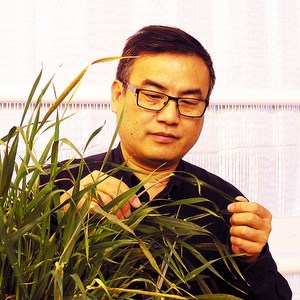The research group led by Chuanxin Sun has generated a rice variety with extraordinary traits. This has been done by manipulations of SUSIBA2, a regulatory gene controlling sugar synthesis and allocation, that greatly increase rice yields while cutting its climatic impacts.
Rice – a major emitter of methane
Rice, growing in waterlogged paddy fields, emits large amounts of methane from its roots. In fact, rice production is responsible for up to 17% of the world's emission of methane, the second most important greenhouse gas after carbon dioxide. SUSIBA2 rice produces 90% less methane than other ("wild type") varieties and still provides 10% higher crop yields.
What Chuanxin Sun and his team have done is to transfer the SUSIBA2 gene from barley to rice. This changes the way rice plants allocate carbon fluxes from photosynthesis to different tissues, causing them to send more photosynthetically generated carbon to stems and grains, and less to the roots.
– By reducing amounts of carbon sent to the roots, we reduce
amounts of root exudates that are converted to methane, in field conditions as well as the lab. We have grown the rice outdoors in China for three years now, with successful results. The rice variety is not patented, so it is now open for use by anyone. Currently, it can't be used in China or Europe, since it is classified as a GMO product, but other are countries interested in using it in rice agriculture, he says.
Top world innovation prize
The development of SUSIBA2 rice was featured in Nature and earned both Popular Science magazine’s Grand Prize for an Innovation in Engineering in 2015 and a prestigious Physiologia Plantarum Award in 2017.
Recently, Chuanxin Sun and his colleagues have extended the scope of possible developments by more fully elucidating the system that controls carbon fluxes in barley. A single gene with two promoters (SUSIBA1 and SUSIBA2) determines not only the allocation patterns mentioned above, but also how much of the photosynthetic products are channelled into starch and dietary fibres (fructan and beta-glucan). Thus, crops with tailor-made starch and dietary fibre contents can be produced. These findings were highlighted on a front cover of the journal Molecular Plant. Lantmännen, a Swedish agricultural company, supports the research and plans to use a variety produced by the team commercially.
Chuanxin Sun explains SUSIBA1/2 regulation as a Yin-Yang system, with an activator and repressor balancing each other in the control of C-fluxes.
The research group is also screening other varieties for variations in SUSIBA2 activity and have found some interesting lines for further research. Moreover, knowledge of the Yin-Yang system may help efforts to improve crops’ lipid contents.
– We also use rice as a model plant in our lipid research. There is great potential to increase cereal’s oil contents by exploiting understanding of the lipid controlling genes and SUSIBA2, says Chuanxin Sun.
/ Text Mats Hannerz.
